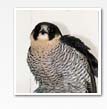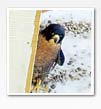View Archived Data collected from
birth to 1 month for 2 Australasian Harriers.
Bird
1
Bird 2
|
Archived Information
Australasian Harriers -
Breeding Season 1993
Eketahuna, New Zealand
November 27, 1993
The nest was on the side of a deep gorge covered with native vegetation,
not typical of Australasian Harrier nesting habitat. There were
possibly four or five eggs in the nest, one resting on top of the
others. The female returned to the nest area on two occasions between
5:00 p.m. and 7:30 p.m. The second time the female was frightened
off by a low flying micro-lite. During this interval the male had
also arrived at the site and spent an hour and a half perched on
top of a small pine tree and was constantly harassed by three and
sometimes four magpies. The male glided to the nest site whilst
being chased by magpies, dropped food he was carrying then immediately
pirouetted down to the nest, staying briefly before flying off again.
Observations of the nest site continued until it was decided to
retrieve the eggs from concern that the nest was abandoned.
The time elapsed from first discovering the nest
when the female flew off to retrieve the eggs was 2 hours and 40
minutes. By this time the temperature was rapidly dropping. Only
three eggs remained in the nest prompting speculation that the remaining
egg(s) was/were either eaten by predators or tossed out by the male
during his brief visit to the nest. The eggs were wrapped in newspaper
and placed in a conventional egg carton and were handed over to
us by the run holder. By 8:45 p.m. the eggs were placed in a still
air incubator which was maintained at an average temperature of
37.5∞ C or 99.5∞ F. The eggs were turned by hand three
times per day 8 hours apart.
The measurement of the eggs were as follows:
1.
2. 46.22 cm long x 37.78 cm wide
3. 47.00 cm long x 35.26 cm wide
The eggs were white in colour but had overall dirty
appearance.
At 2:20 p.m. on December 8th a small raised cracked bump was observed
on the side of the shell and cheeping was heard. On December 9th
the pipping was slow and the egg was checked at 10:00 p.m. At 2:00
a.m. on the 10th and at 5:00 a.m. the chick was assisted out of
the shell. The process took 1 hour. The chick at birth was blind
with very little down covering the body. The soft body parts including
most of the beak was pink and the claws were white. Just a small
portion of the upper mandible was black. The chick was left inside
the incubator and allowed to dry off. Hatch weight was 23 g. The
eyes remained closed for the first day and a half. After 8 hours
the chick was force-fed several small pieces of ground quail dipped
in saline solution.
On the 11th of December at 3:30 p.m. a very small
crack was observed in the second egg but pipping progress was very
slow, most probably due to the drying out of the membrane inside
the shell. Cheeping, although audible at first, after 12 hours became
faint. Also the direction of pipping was not following the perimeter
of the air cell but going down toward the pointed end of the shell.
The egg was checked at 2:00 a.m. on the 13th of December and again
at 4:00 a.m. Egg shell fragments were removed over a period of two
hours making it possible to assist the chick out. Although some
bleeding occurred and the chick was very weak it was decided to
leave the chick in the incubator with its sibling. At 6:00 p.m.
the chick was force-fed several small pieces of quail. A similar
hatch weight of 23 g. was recorded.
By mid-morning on the 14th of December the remaining
egg was beginning to pip but no progress was made for the remaining
24 hours. The outer membrane of the air cell was leathery and despite
efforts to assist the remaining chick out on the 15th of December
the chick died within a few minutes of being assisted out.
The remaining chicks increased in size and weight. Refer to daily
notes during feeding regime.
View Archived Data collected from
birth to 1 month for 2 Australasian Harriers.
Bird
1
Bird 2 |
|

